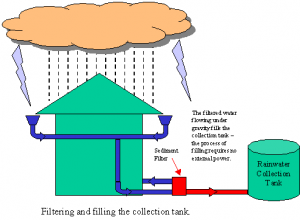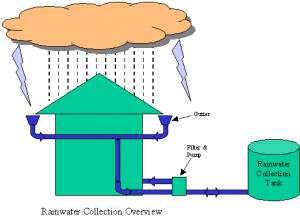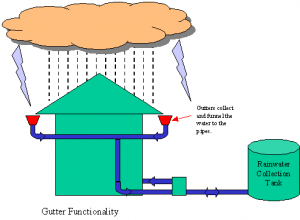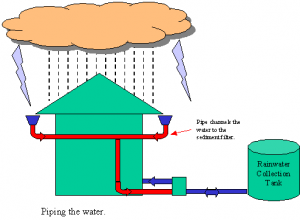Water plays a significant role in our lives since it is a precious natural resource. Over the past few years, there has been an increase of water shortages in several parts of the world. It is vital that ideal measures are put in place to help to reduce the high rate of water loss. With the change in climate patterns, people need to be aware of the alarming water shortage that we face currently and the imminent danger of severe shortage in the future. Various methods can be implemented to address the water problem in the most area. Rainwater harvesting is one of the methods that can be used for water conservation.
What Is Rain Water Harvesting?
So what is rainwater harvesting? It is a technique or strategy for the collection of rainwater and storing it in the right way for future use. The water can be collected from various surfaces and platforms and stored for later use. In most cases, the water is usually collected from rooftops and other hard surfaces. Rainwater harvesting is considered as a very reliable way to conserve water.
(Click on the images below to enlarge)
This technique has been around for a very long time, practiced in the ancient times. Over the past years, this ancient method of water storage has grown quite popular. It plays a vital role in reducing the use of potable water and increase reliability on rainwater.
Advantages of Rainwater Harvesting
In both urban and rural setting, harvesting can be done by the use of infrastructure. One of the simplest ways of storing water from the collection is storage tanks. In most cases, the harvested water is usually redirected to storage tanks, cistern or reservoirs. The water is usually stored for later use. The roof of buildings is the best way to harvest rainwater. There are numerous advantages in doing so.
1. Easy to Maintain
The use of rainwater harvesting system provides ideal merits to any community. First and foremost, the collection offers a better and efficient utilisation of energy resource. It is important because potable water is usually not renewable, thus reducing wastage. The systems used for water collection is based on simple techniques that are very easy to maintain. The overall expenses used in setting up harvesting methods are much cheaper compared to other purifying or pumping means. Also, its maintenance is feasible on the economic front as it does not require deep pockets.
2. Reducing Water Bills
Water that has been stored from harvesting water can be used for several non-drinking purposes. It will immediately reduce one’s utility bills. It is ideal for both residential and commercial properties.
3. Suitable for Irrigation
Harvesting allows the collection of large amounts of water. Most rooftops provide the necessary platform for collecting water. Rainwater is usually free from harmful chemicals, which makes it ideal for irrigation purposes.
4. Reduce demand on Ground Water
Another important advantage is that it reduces demand for potable water. It is important especially in areas with low water levels.
These are some of the significant advantages of harvesting rainwater.
Techniques of Rainwater Harvesting
The collection of rainwater can be done in various methods depending on a few factors. A few common methods include the following:
1. Rain barrels
It is the easiest and affordable method of rainwater harvesting, especially at home. It is where barrels or water tanks installed below the downspouts of the rooftops guttering system. The water is then funnelled/directed into the tanks. The tank can be connected to provide backup water to your current plumbing system, or it can be attached to a pipe for drip irrigation. The use of barrels or tanks is ideal since it can store significant amounts of water.
2. Dry System
It is similar to the barrel’s system, but with the dry system, a larger storage container is used. The container is usually a few meters away from the property. The gutter is redesigned so that water is diverted to the large storage tank. It is a quick and cheap method to implement but has significant rewards.
3. Wet System
It is a technique that is entirely different from the dry system. Here, the collection pipes will always have water in them. It is because they will be situated underground. In the wet system, many collection pipes are connected to the downspouts of a building and diverted into a storage tank, which is also underground. The pipes need to be secure and well maintained to ensure there is no leakage into the soil.
4. Green Roof
This method of harvesting does not need the use of storage tanks. Instead of storing the water in a reservoir, the water is channeled straight to the garden. The process will require installing a drainage system on a building’s roof straight to the backyard. It is a very low maintenance method.
How Rainwater Harvesting Solves Water Shortage?
Harvesting and collection of rainwater is a proper way that can be used to address the problem of the water crisis in various parts of the world. This simple water conservation method can be used to put forward a remarkable solution in areas where there is enough rainfall but not enough supply of groundwater.
Bangalore is an excellent example where rainwater harvesting can become very beneficial. Bangalore is an area with a very high population and an area that also has to deal with water shortages. With these in mind, practicing water conservation methods such as rainwater harvesting is an ideal way to ensure increased supply of water.
Bangalore experiences quite an immense amount of rainfall almost throughout the year. Hence, rainwater harvesting will play a huge role in providing additional sources of water. During the dry season, people will be able to have water sources if they have implemented the necessary kind of harvesting techniques. With increased demand for water, rainwater collection can be able to meet the requirements.
When builders and architects are designing a new home or building, it is important that they think of implementing rainwater harvesting methods. It will be able to reduce reliability on other natural resources for groundwater. In the long run, there will be energy savings, water savings, and resource savings.
-Article by: GoSmartBricks







